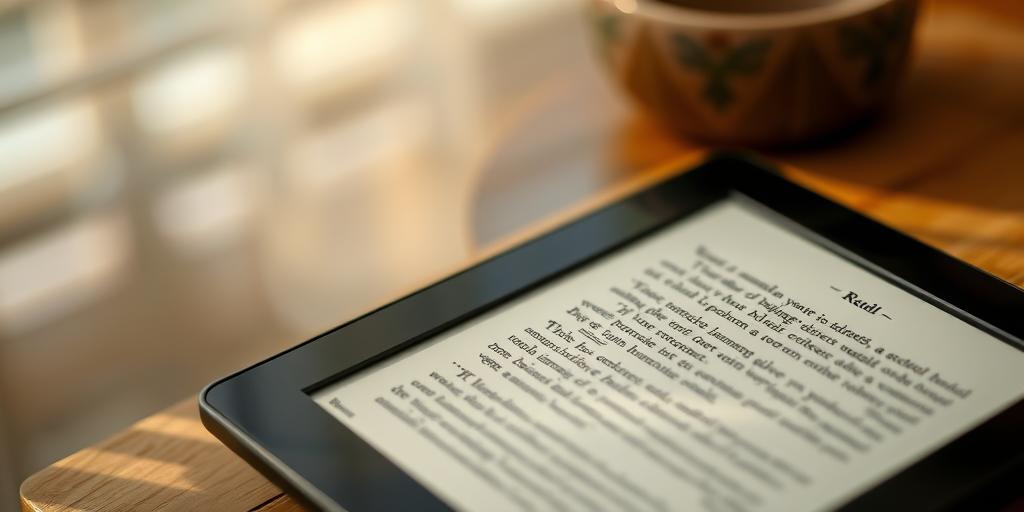Have you ever wondered what makes e-readers so easy on the eyes, so different from staring at a bright backlit screen? The secret sauce is E Ink, a revolutionary technology that’s transforming the way we read digital content. But what exactly is E Ink, and why is it the undisputed champion of e-reader displays? Let’s dive into the fascinating world of electronic ink and uncover its magic!
Decoding the Mystery of E Ink
E Ink, or electrophoretic display, isn’t ink in the traditional sense. It’s a display technology that mimics the appearance of ink on paper. Millions of tiny microcapsules are sandwiched between two electrodes. Inside each capsule are white and black particles suspended in a clear fluid. When an electric charge is applied, either the white or black particles move to the surface, creating the illusion of text or images. This unique process is what gives E Ink its remarkable characteristics, like its paper-like appearance and low power consumption. Unlike LCD or OLED screens, E Ink doesn’t require a constant backlight, contributing significantly to its energy efficiency and extended battery life. This is why your Kindle can last for weeks on a single charge! Isn’t that amazing?
How E Ink Displays Work: A Closer Look
The process is surprisingly simple yet ingenious. Each microcapsule acts independently, allowing for incredibly precise control over the image displayed. When you turn a page on your e-reader, the electric charge changes, causing the particles to rearrange and display the new content. This contrasts starkly with LCD or OLED screens, where pixels are constantly refreshed, leading to higher energy usage and potential eye strain.
Advantages of E Ink Technology: A Paper-Like Reading Experience
E Ink boasts a range of benefits, making it the go-to choice for e-readers and other display applications where readability and low power consumption are paramount. The most obvious advantage is its paper-like appearance. The lack of backlighting eliminates glare and reduces eye strain, providing a more comfortable reading experience, even in bright sunlight. This makes it the perfect companion for outdoor reading enthusiasts. Imagine that: reading your favorite book in the park under the bright sun without any eye strain. It’s fantastic!
E Ink vs. LCD and OLED: The Great Display Showdown
While LCD and OLED screens dominate the smartphone and tablet market, E Ink reigns supreme in the realm of e-readers. But how does E Ink compare to its rivals? Let’s take a closer look at its advantages and disadvantages.
E Ink’s Advantages Over LCD and OLED
- Readability: E Ink’s paper-like appearance is far easier on the eyes, especially during prolonged reading sessions. It minimizes eye strain and reduces headaches compared to the backlit displays of LCD and OLED.
- Power Consumption: E Ink consumes significantly less power. This translates to longer battery life, a crucial advantage for portable devices like e-readers. You won’t need to charge your device as frequently.
- Sunlight Readability: E Ink displays are exceptionally readable in direct sunlight, unlike LCD and OLED screens, which can be difficult to see in bright conditions.
E Ink’s Disadvantages Over LCD and OLED
- Refresh Rate: E Ink displays have a relatively slow refresh rate. This means there’s a noticeable delay between page turns, which is not ideal for applications requiring rapid screen updates. But for reading, this is negligible.
- Color: While monochrome E Ink is perfect for reading text, color E Ink displays are still in their early stages of development and aren’t as vibrant or high-resolution as LCD or OLED.
- Cost: E Ink technology can be more expensive to produce compared to LCD or OLED.
The Future of E Ink: Beyond E-Readers
While E Ink is most closely associated with e-readers, its unique properties are opening up new possibilities. We are seeing its application in other areas: from digital signage and smartwatches to labels and even educational tools. The potential uses are vast and exciting. The technology’s low power consumption, paper-like readability, and long battery life are highly coveted in many applications. What else will we see made with this technology? It’s sure to be exciting!
The Exciting Applications of E-Ink Technology
- Digital Signage: E Ink displays are being used in low-power digital signage, especially in locations where energy efficiency is crucial.
- Smartwatches: Some smartwatches use E Ink displays to extend battery life.
- Labels and Packaging: E Ink’s ability to change its display makes it ideal for dynamic labels and packaging that can update information.
- Educational Tools: E Ink is finding its way into educational materials, providing students with interactive and easy-on-the-eyes textbooks.
E Ink technology has truly revolutionized the way we read. Its paper-like appearance, low power consumption, and exceptional readability make it an ideal choice for e-readers and beyond. Ready to experience the difference? Go grab an e-reader and start reading today!




